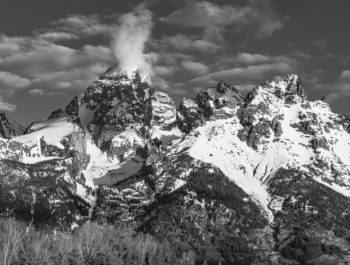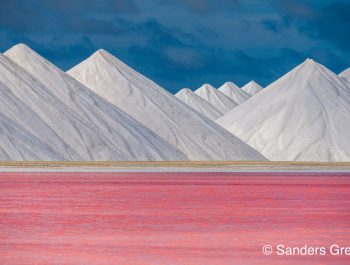Sustained By Nature
Background To The Project
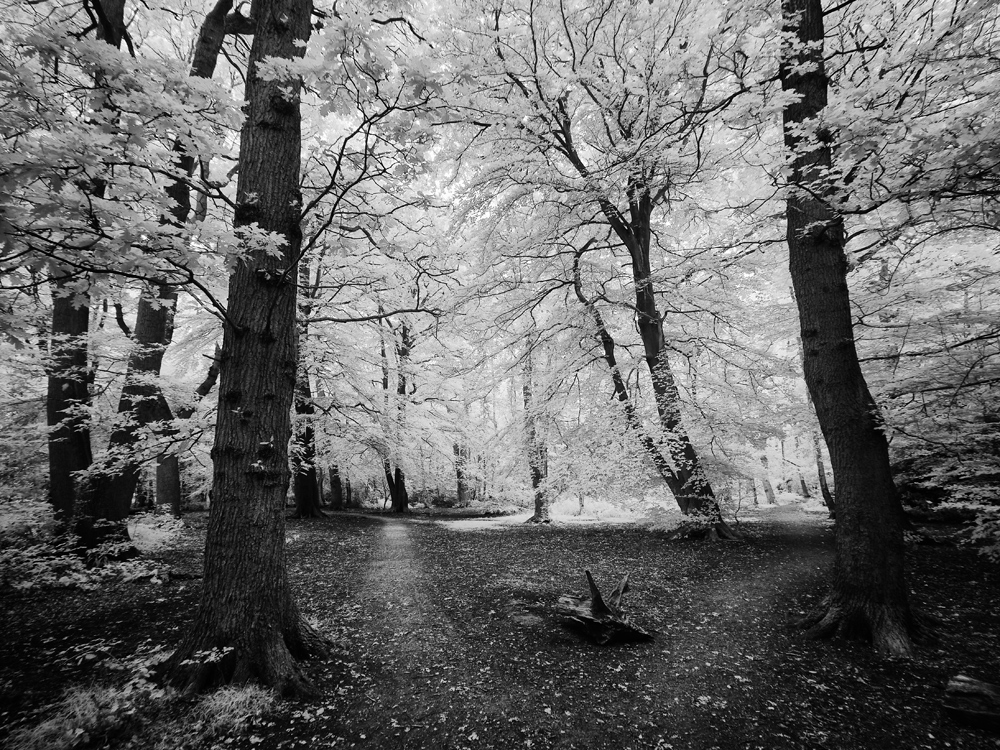
Hookstone Woods is a small (around 22 acres) of woodland located on the outskirts of Harrogate, a small town located in North Yorkshire in northeast England. It is a mixed woodland of native trees and also has two small ponds created from old quarries. It was once part of the ancient Forest of Knaresborough and is now a nature reserve popular with dog walkers. In fact, walking my own dog there is how I first became connected to the place.
Given its proximity to my home, I have long considered undertaking a project to photograph the woodland in its many guises throughout the year. But, as can so often be the case, it is easy to take the locations close to home for granted, succumbing to the sirens call of distant and more exotic places. I have photographed the woods on an intermittent basis but not with the dedication or commitment I kept promising myself that I would give it.
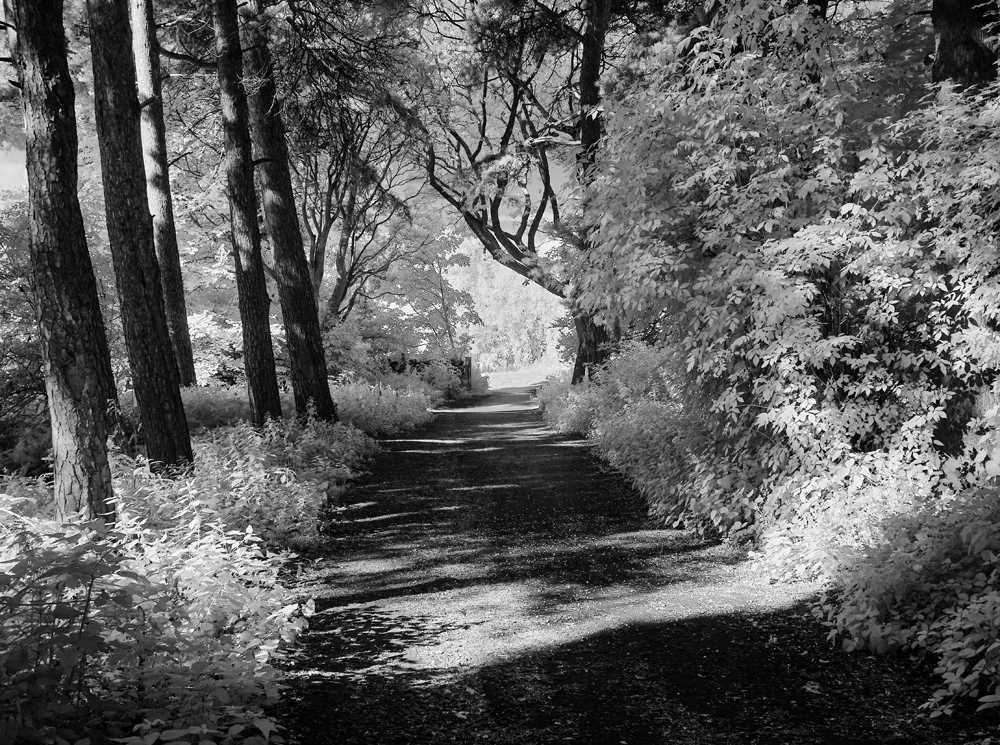
However, in the spring and summer of 2020, the pandemic Covid19 changed all that. The country went into lockdown – freedom of movement was curtailed, people were asked to stay indoors, only allowed to venture out for limited exercise and essential activities like shopping. My overseas trips were canceled for the foreseeable future and even traveling to the relatively nearby Yorkshire Dales was not possible for a long time. I was missing my connection with nature and started to appreciate and value more this small area of woodland.
Every day I would try to walk my dog there. We would stop and rest (at 11 years old he cannot romp through the woods as he used to). I would find a patch of light where the sun was breaking through the canopy of leaves overhead, stand with the sun on my face, and with my eyes closed, I would listen to the birds. With no background hum of distant vehicles, the sounds of nature were intensified. It was rejuvenating. In the face of everything going on around the world, this small area of woodland became my oasis of tranquility, the place where I went to recharge my spirits. With every visit, my relationship with the woods deepened.
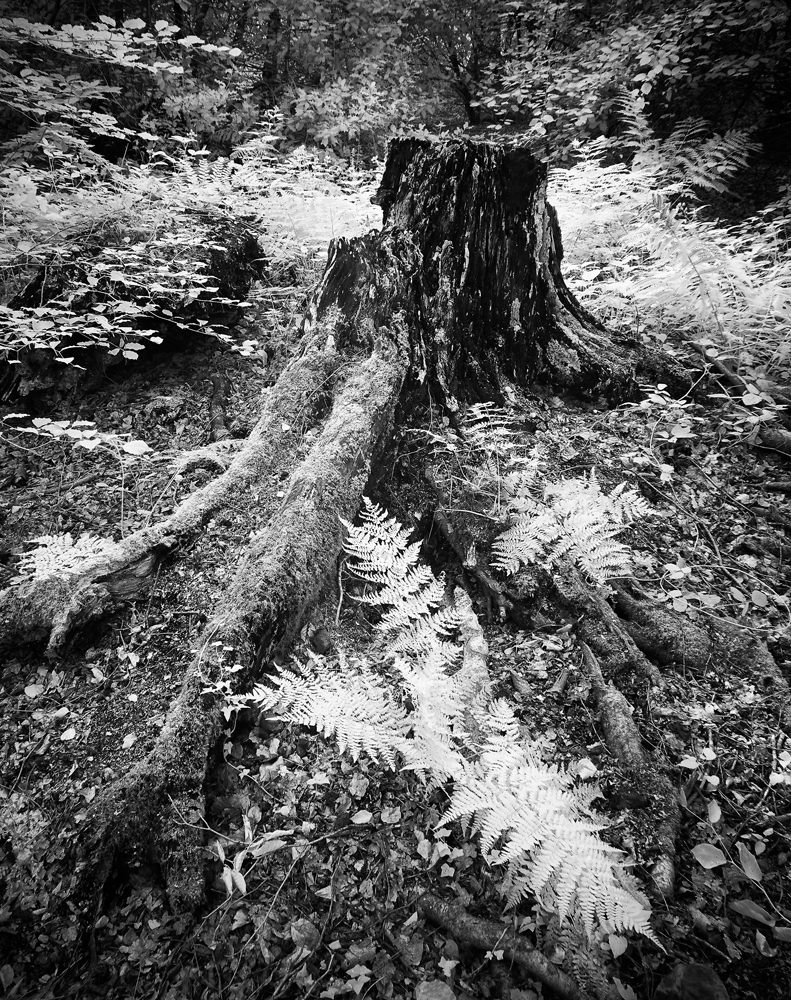
I became familiar with individual trees – the texture of their bark, the twist, and turn of their trunks created as they had searched for the light. I sought out hidden corners, far from the paths that wind through the woods, seeking even quieter places for moments of thoughtful solitude.
I am always advocating that we should photograph our passions, the things that stir an emotional reaction in us, so I resolved that once lockdown was eased I would return with my cameras.
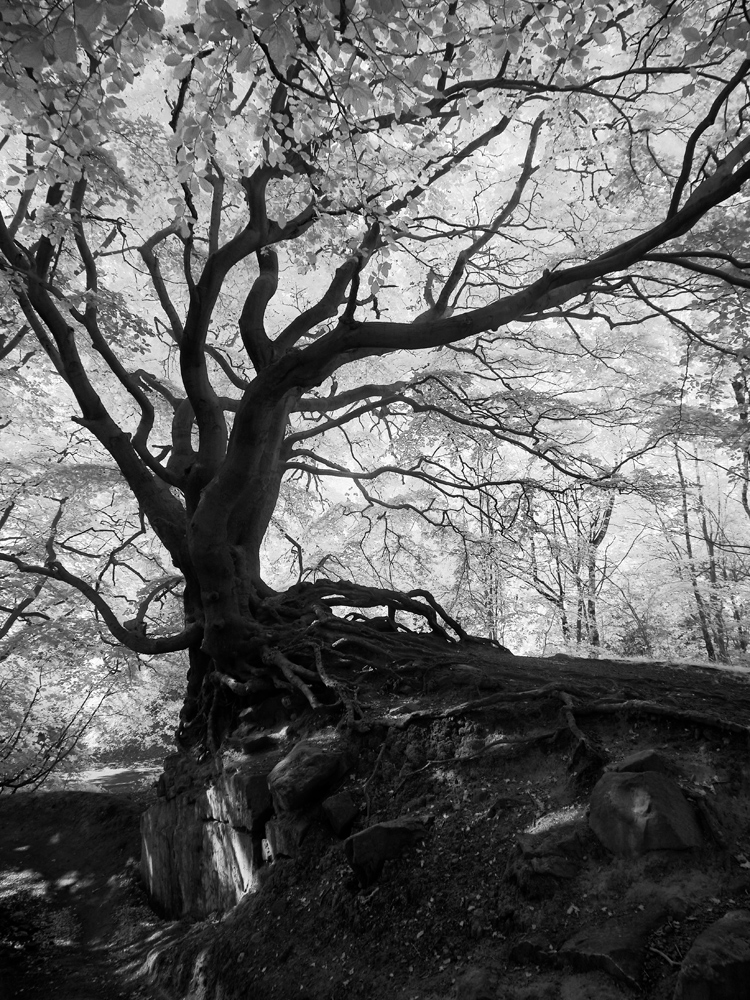
On my subsequent photo explorations there I tried to capture the variety of emotions I was experiencing – the joy of nature, a connection with a simpler, less troubled world, and getting sustenance from the reminder that in the woods life went on relatively untroubled. All this in the context that in the outside world, beyond the boundaries of the woods, there was an inevitable focus on illness, death, economic uncertainties, and the disruption to lives and travel that had been caused by Covid19.
I have produced a one-off book that contains the images from my photographic visits to the woods in the summer of 2020 (some illustrate this article) and that will serve (at least to me) as a reminder of this difficult time.
Photographing Woodland
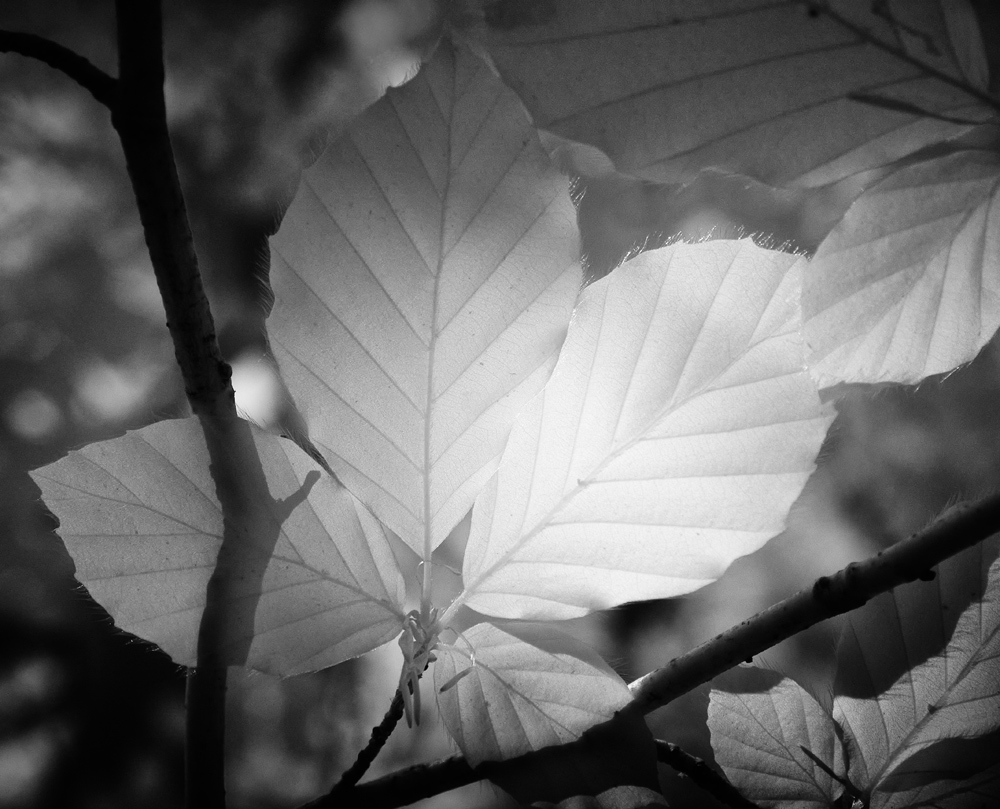
Woods are generally challenging places to photograph. Coping with extremes of light and shade creates problems not just in testing out the dynamic range of any camera but also in adding a sense of confusion to what is already a chaotic and unstructured environment.
Creating a pleasing, ordered design in woodlands is a test of any photographer’s compositional skills.
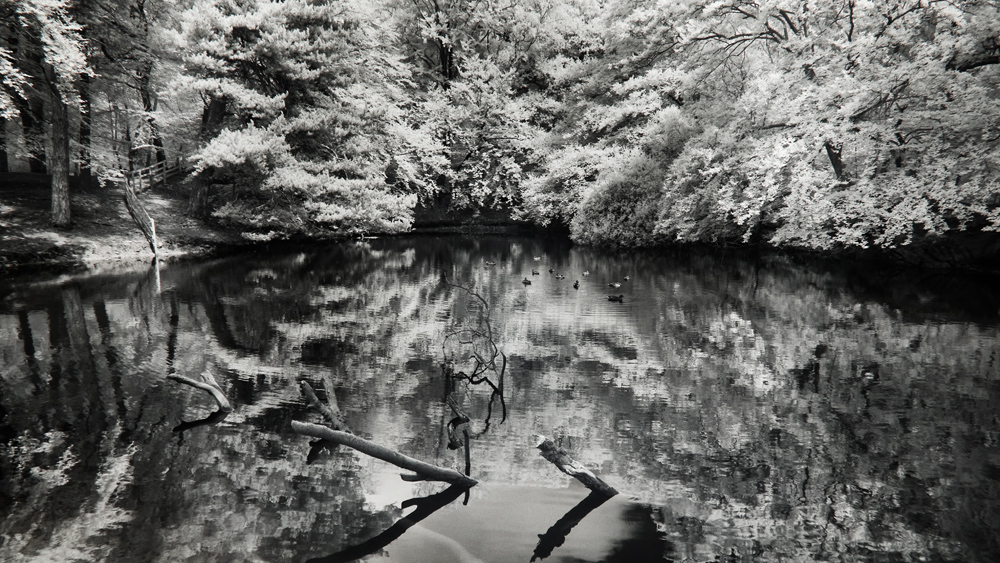
Or the alternative is to forget about creating order, instead to just respond to and photograph the chaos. Jan Tove, Swedish nature photographer, in his book ‘Beyond Order’ talks about the need to accept and love the chaotic nature of the natural world: –
“If we only see the orderliness in nature, we just skim the surface of the complex world we live in”.
His advice is to embrace the confusion and not try to impose any sense of coherence.
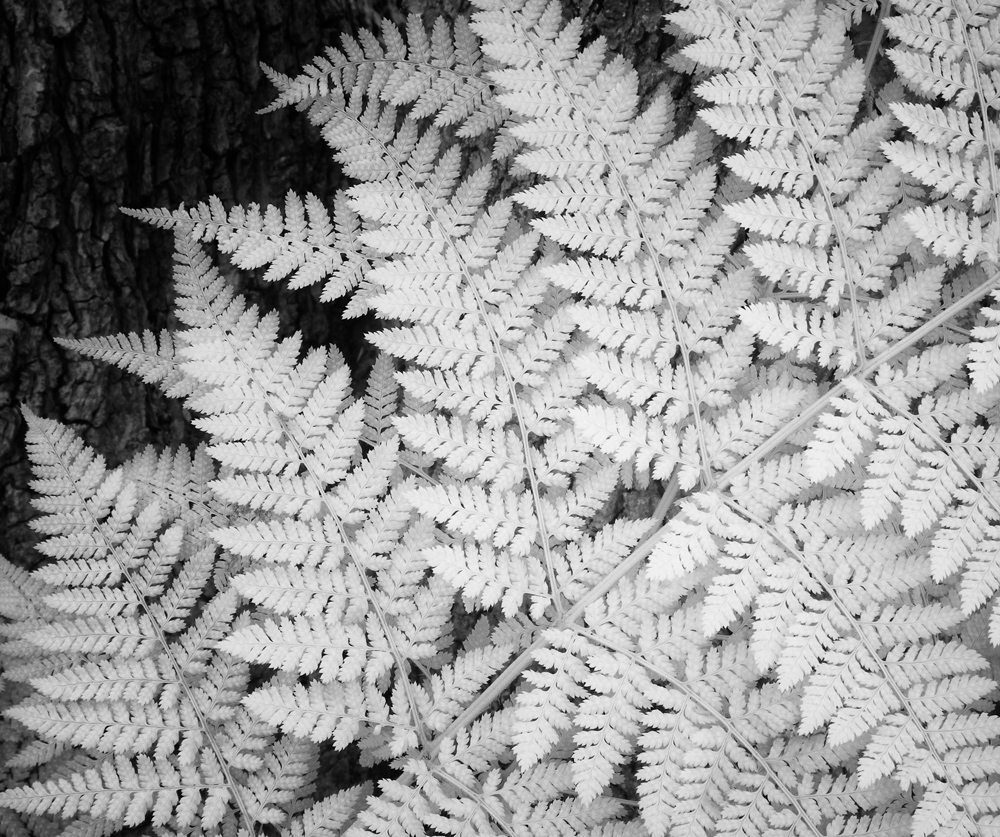
Having acknowledged this alternative view I must admit that my usual approach is to try and create some visual order in what I am seeing. To look for compositions that use line, shape, tone and balance to take the viewer on a visual journey around the image. My preference for minimalist, simple compositions, where I remove visual clutter from the photograph, is always challenged in woodland settings. And that’s why I enjoy photographing them so much – it forces me to work out of my comfort zone.
With this project, I decided to combine both approaches.
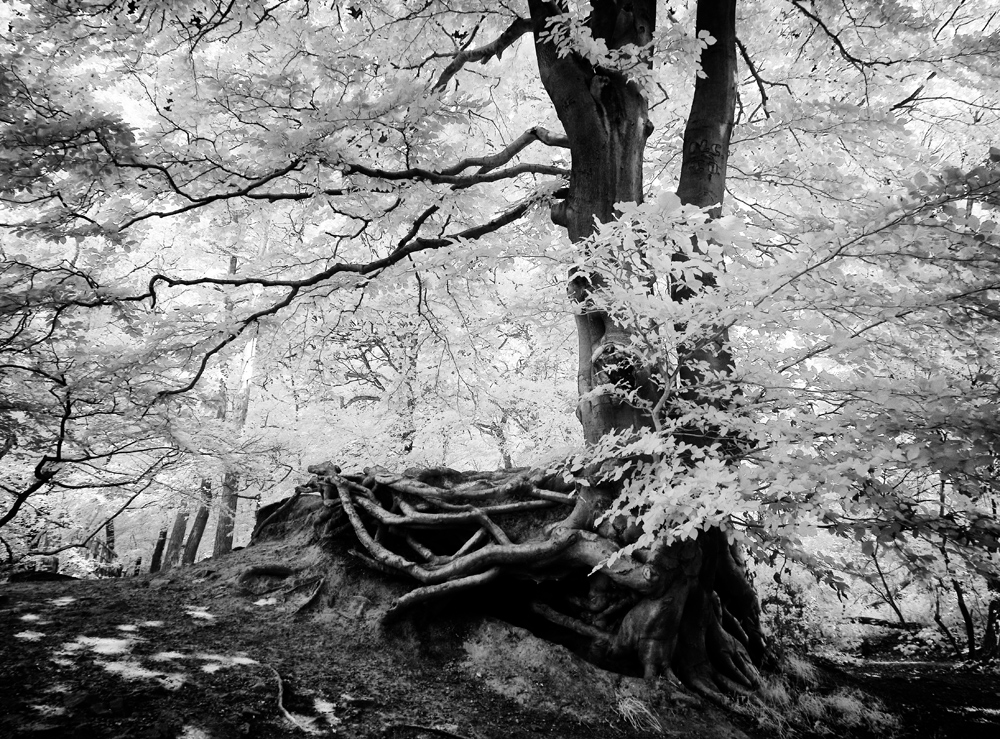
True to this spirit of working with the elements as I found them, rather than how I would choose them to be, I also decided to adapt to whatever the light conditions were on the days I visited. I usually try to avoid photographing woodlands in bright, contrasty light for the reasons mentioned before. My preference is to photograph woodlands in soft, gentle diffused light. But for this project, I chose to go with whatever Mother Nature provided me with – to accept less than ideal conditions and adapt to whatever I was presented with.
I also opted to shoot the woods with my Olympus OMDs (an EM5 and EM1ii) that I have had converted to record infrared light. Primarily this choice was influenced by the time of year – the vibrant green, chlorophyll-rich leaves of early summer reflect a lot of infrared light. Shooting infrared also enhances the tonal contrast between the foliage and the tree trunks and branches, highlighting the structure of the woods more clearly.
Photographing Infrared Light
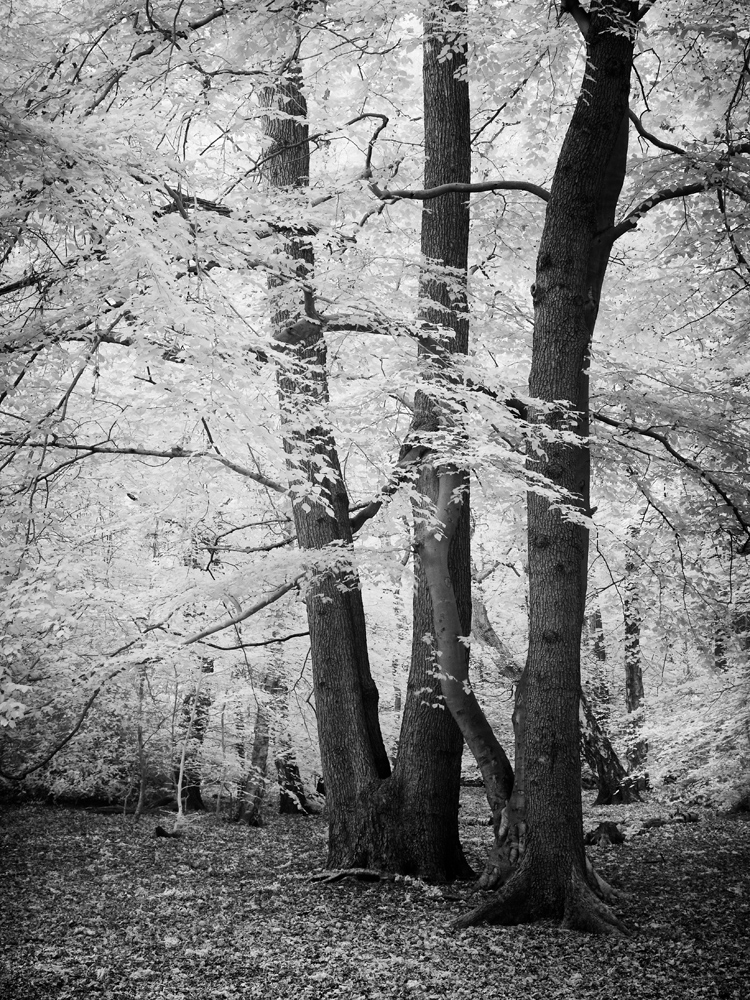
So, what is infrared light? Simply, it is all around us but invisible to the human eye. A more complex definition is that it is invisible radiant energy with longer wavelengths than normal light. Wavelengths are measured in nanometers (nm) with visible light in the range from 400 to 700 nm. Infrared light is present from around 700nm.
If it is invisible, then how can it be recorded by a camera? In the days before digital photography specialist film could be bought that was sensitive to infrared light, that had to be loaded and unloaded in the dark to avoid fogging. With digital cameras there are two options: –
1) to use a conventional camera fitted with a filter that blocks visible light (for example a Hoya R72 or B&W 092 filter). This has the advantage of retaining the camera’s capability to record visible light but as the filter is opaque then exposures are long, requiring the use of a tripod as well as composition and focusing being carried out before the filter is fitted; or
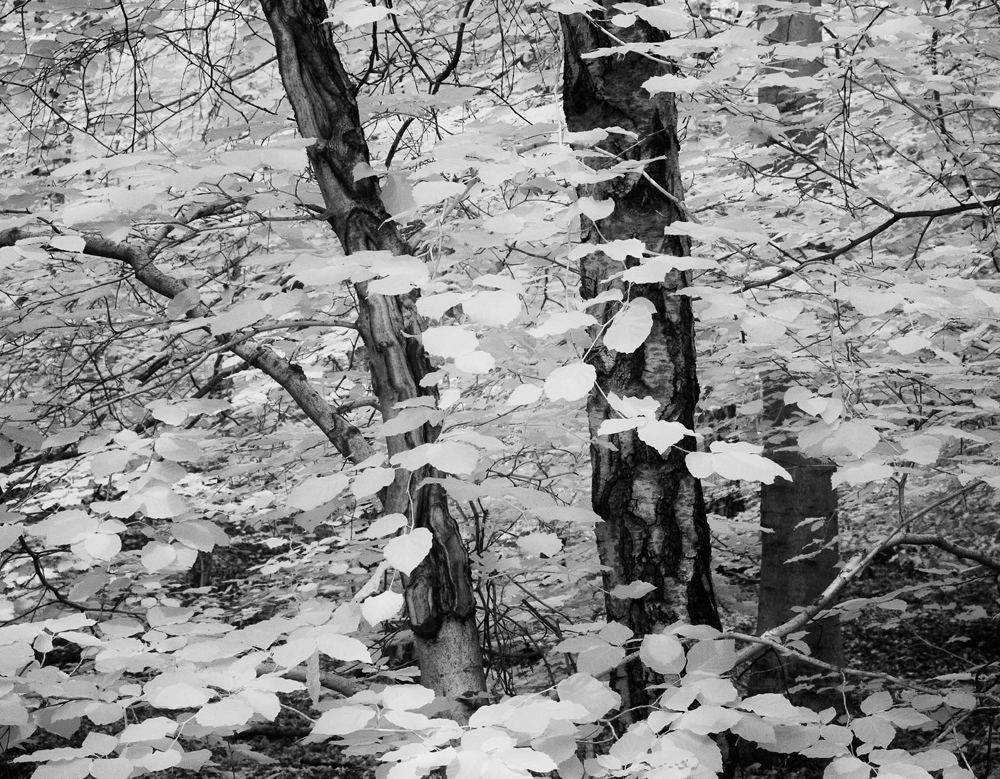
2) get a digital camera converted to record infrared light. This involves replacing the low pass filter in front of the sensor with a piece of glass that cuts out at least part of the visible light spectrum. Various conversion options are possible to give some or no color in the RAW file. I chose to have my cameras converted to 830nm so they only record B&W data.
A converted camera does not require any extended exposure times, making handheld shooting possible. And using a custom white balance also means that what I see on the cameras display more closely resembles the final image. However, a full conversion means that the camera can only record infrared light – visible light photography is no longer possible so going down this route requires a commitment. For this reason, converting an older, less-used camera is advisable.
As infrared light focuses at a different wavelength from visible light then it is not possible to rely on the AF system of a DSLR (but using live view does get around this problem). One of the advantages of getting a mirrorless camera converted is that generally contrast-detect AF is used and is based on the actual image reaching the sensor. Adapting a mirrorless camera also means that what you see in the viewfinder is what you get, making composition and focusing a straightforward affair, no different to shooting visible light.
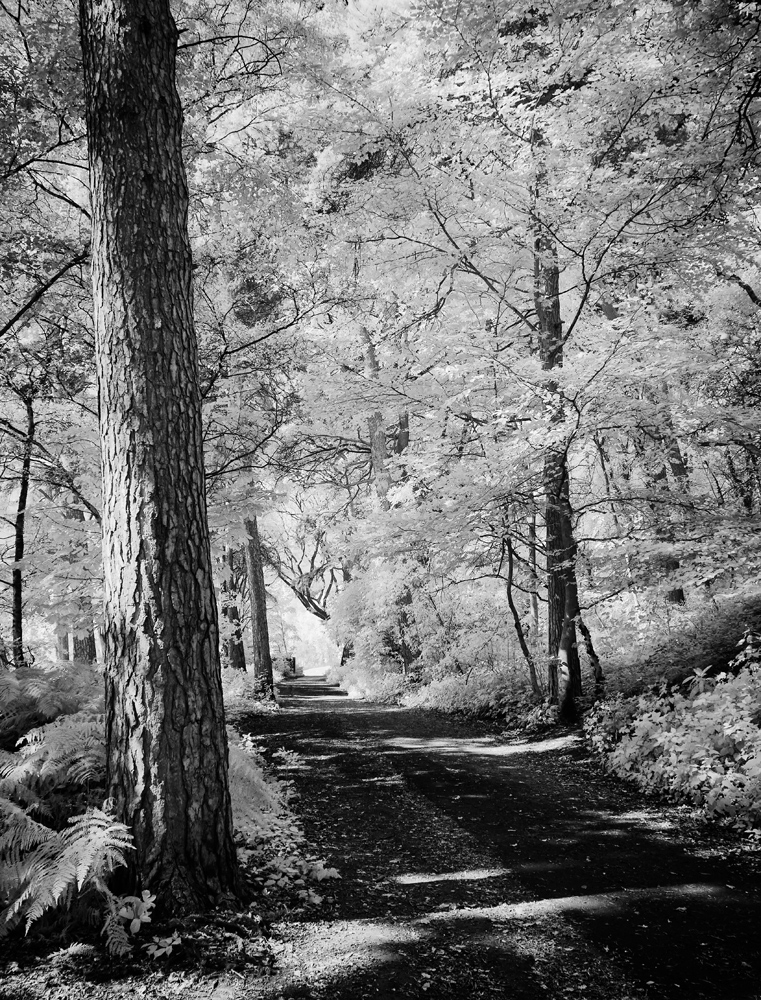
Metering with a converted digital camera is also just as simple and I use the histogram to confirm that I am obtaining a full range of highlight and shadow information on the recorded file. One difference with infrared photography is that I do not employ the ‘Expose to the Right’ principle as strictly as I would do normally. When shooting a RAW file with conventional image-making, I ensure that the histogram is as far over to the right as possible, without losing highlight data. However, with infrared photography, I try to keep the histogram further away from the right-hand edge to ensure that I retain as much highlight detail as possible.
One common problem with shooting infrared is hotspots in the center of the image. Almost all lenses are designed to give their optimal performance in visible light and generally, the more expensive the lens the better the results. But this is not true when shooting infrared. In fact, I have found that better performing lenses tend to be the cheaper ‘consumer’ optics rather than their ‘Pro’ designated counterparts. The lenses I have used for my woodland project have been the Olympus 9-18mm and 12-50mm and these have never given me a problem.
This is the second project that I have used my infrared cameras for. The first was ‘The Forgotten’ (a series of images taken of a cemetery in West Yorkshire where nature is reclaiming the once-grand monuments dedicated to the people who were buried there in the 18th and 19th centuries – see HERE. As with my woodland project, recording infrared light helped to achieve a tonal separation from the foliage and the other elements in the composition that was not as apparent in standard black & white.
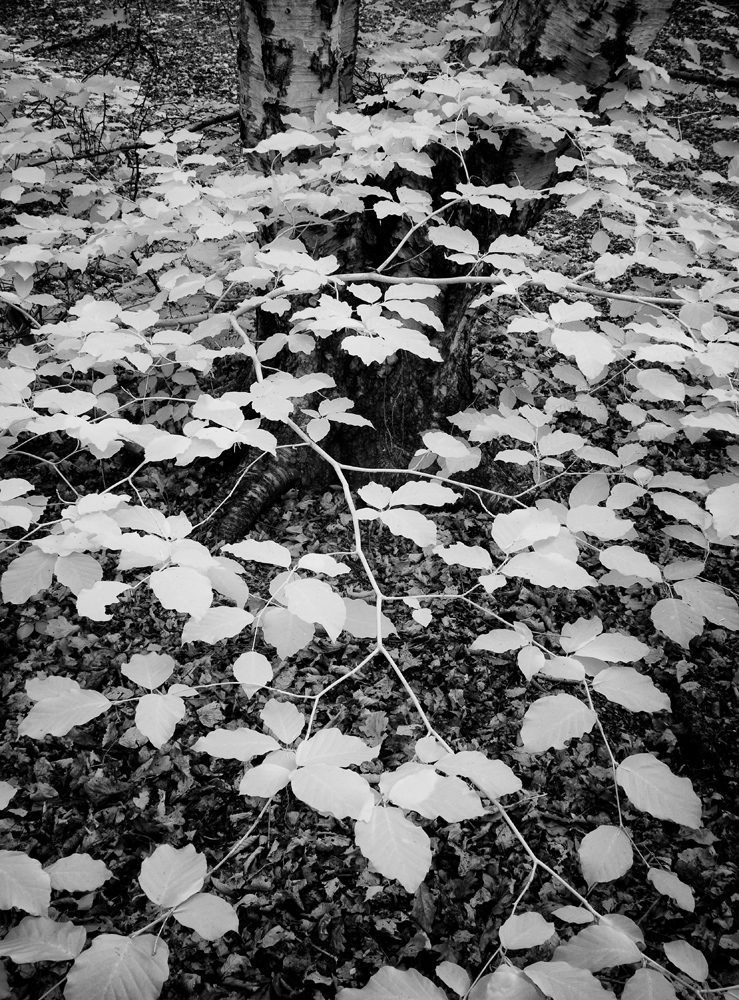
The great news for those landscape photographers who like their sleep is that the dramatic, warm light of dawn or dusk is not essential to effective infrared images and the harsh light of midday can be a good time to shoot. Not only that but I have discovered that almost any light can be good light.
Prior to working on my ‘The Forgotten’ project, I had assumed that infrared photography required bright sunshine, to create that dark skies/bright foliage look so typical of the genre. But the experience taught me that successful images can be made on an overcast day too when the light is softer and more diffused. In fact, many of my favorite images from both projects were taken in gentle, non-directional light.
One of the other advantages of infrared photography is that it helps to elevate familiar scenes, to enable them to transcend the ordinary and, by representing them in different ways, can create impact. But a health warning – do not fall into the trap of letting that lull you into assuming that good photographic principles and discipline can be ignored. For example, good compositional design is still very important and a rubbish shot is still a rubbish shot whether you are recording visible or infrared light.
Post-Processing Infrared Images
I always shoot a RAW file as the starting point for an image. This gives me the best file quality and enables me to work a file without compromise. Having said that, I try to do as little in post-processing as I can, always striving to get the image as right ‘in-camera’ as I can.
Attention to the histogram at the shooting stage is crucial (as described above) to ensure I maximize the tonal range. If I get this right then post-processing is limited to an adjustment to Levels and Curves in Capture One (my RAW converter of choice) with some local dodging and burning to selected areas to bring out or subdue details to taste.
On occasions, when I have experienced a hotspot in the center of an image, I have used a radial gradient mask over the affected area in Capture One and then reduced brightness and lifted the contrast to sort this out.
Further Information
Various companies offer IR conversions so a quick internet search will generally identify a provider in your own country. I had my Olympus cameras converted by Protech (based in Sussex in the UK) –
The Infrared Photographic Society can be found on Flickr .
One of the most well-known exponents of infrared photography was Sir Simon Marsden and although he died in 2012 his wonderful work can still be seen in the Marsden Archive.
I am planning to run some infrared workshops (once Covid 19 restrictions allow) where participants will be able to borrow converted Olympus cameras for the duration of the workshop. If you would like to be kept informed about these please sign up for my Newsletter here .
If you would like to buy a copy of my book of IR images, The Forgotten’ further details can be found here.
Steve Gosling
September 2020
Harrogate, North Yorkshire
I am a UK based professional photographer who loves black & white photography. My photographs have been widely published & exhibited internationally and has won many awards – most recently achieving an ‘Honor of Distinction’ in the prestigious international ‘B&W Spider Awards’ in 2018. I enjoy writing & teaching about photography and have run a successful workshop programme for nearly 20 years, encouraging and inspiring photographers from across the world. I am an Ambassador for Olympus, Gitzo & Permajet inkjet papers as well as working closely with Phase One and Lee Filters.





